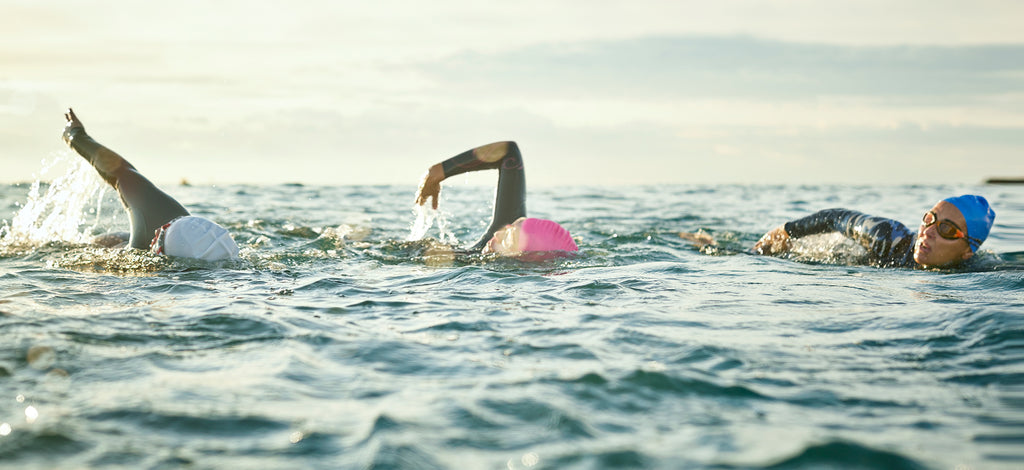8 Open Water Swimming Tips for Every Triathlete
For many triathletes, the open water swim is the most daunting and unpredictable part of the race. Swimming alongside hundreds of fellow racers in varying conditions is nothing like a pool swim! And when most triathlons go ahead even in unideal conditions, triathletes must be prepared for any situation, including rough waves, winds, and cold water.
How do you start open water swimming?
The best open body of water to train in is the one you already know.
For new open water swimmers, it’s normal to experience anxiety about taking the plunge; the water is darker, colder, and—depending on where you swim—deeper than pool swimming.
Make sure to read up on the areas you’re swimming and make a note of any riptides or undertow patterns. When you get to the lake, river, or beach, look again for uneven tides where waves overlap one another from side to side, or darker waters—telltale signs of a riptide.

Before you get in the water, look out for any wildlife and other swimmers or boaters. Start with a short distance swim to get acquainted with the water conditions and temperature, and take in your surroundings in and out of the water. Always be aware of Open Water Swimming Safety when preparing for your training.
Choose open water with a clear swimming target, like swimming across a river or lake, or a spot with a buoy. This will help track your swim metrics more accurately and prepare you for race day if you don’t have smart swim goggles.
Is open water swimming harder than swimming in a pool?
While each comes with its unique challenges, open water swimming is objectively harder because of the unpredictable conditions, cooler temperatures, and lack of direction. With preparation and practice, however, you can confidently swim in open water to train for your triathlon.
8 Open Water Swimming Tips
Now that we’ve put open water swimming into context let’s get into tips and techniques to use during training and your race to make sure you’re safe and successful.
1. Practice proper breathing
You might get a clear day and still waters —ideal for swimming— until someone is splashing alongside you. Making sure you breathe without getting a mouthful of water is the first step to preparing for a strong open water swim. If you need to practice breathing, here are our five breathing tips for open water swimming.
2. Prepare for open water in a swimming pool
If you only have a pool to practice in or want to work up to open waters, you can recreate open water conditions by swimming first thing in the morning when the pool is coldest. Train with a couple of friends to create waves and turbulence comparable to race day. In more turbulent water, you’ll have to do more strokes and build up your stamina. Use a pull buoy to practice breathing with your legs aligned and strengthen your stroke.
You’ll need to be able to swim straight without reliance on lane ropes, so remove them if possible. You can practice spotting in the pool by looking toward the same tile, sign, or any other landmark.
3. Get the right open water swim equipment
A common theme throughout this article will be preparedness, as open water can be more unpredictable than a pool. Having the right gear is no exception! Before you dive in, gather your equipment according to the type of open water, your swim level, and the weather.
A swim cap is a standard for reducing drag, keeping hair out of your face and vision clear, and keeping your head warm in colder waters.

Goggles will obviously make it easier to see while swimming and prevent irritation if you’re swimming in saltwater. With a high-quality pair of smart swim goggles, you can track metrics like distance traveled, pace, and stroke rate—all within a smart lens display that doesn’t disrupt your swim.
April 2024 update: Most FORM Smart Swim goggles now include SwimStraight™ - an in-goggle compass to help you swim in a straight line.
Earplugs can make an open water swim more comfortable and reduce audio stimulation, making it easier to focus. It also can help prevent a rogue wave or swimmer’s stroke from propelling water into your ear.
Wetsuits are designed for cold water swimming and, if permitted, should definitely be worn! It will help you swim faster and increase your buoyancy and comfort in cooler temperatures. A wetsuit isn’t your only option in open water, so be sure to check out our guide to triathlon swimwear if you’re swimming in warmer water.
While you can’t wear fins during the triathlon, they can be very helpful for training and getting comfortable in open water. If waters are choppy or you encounter a wake, having the added push to get back to shore is essential.
If you’re working on improving your arm strength and balance in the water, a pull buoy will keep your hips aligned and legs spaced to maximize reliance on your strokes. If you start to experience muscle aches in the water, remove the pull buoy and use your legs to relieve the pressure on your arms.
Finally, a safety buoy is a must if you are swimming around boats. These bright blow up buoys tie around your waist and drag behind you, making it easy for boats to maintain a safe distance, and improving visibility for those swimming with your or watching from the shore.
Once you’ve found the right equipment for your swim, it’s time for the next phase of preparation; research. While this isn’t the first thing you think of when preparing for a triathlon, it will be essential for your training.
4. Check the forecast
This one might seem obvious, but it’s especially important when swimming in unfamiliar waters. Light precipitation and winds are fine for training and will prepare you if race day conditions are less than ideal. However, you should never swim in open water if you feel unsafe or if there’s a storm brewing.

Look out for choppy waves and whitecaps, and keep an eye out for dark clouds or increased winds in between intervals before continuing.
Rivers
The closer to the middle of the river you are, the faster the current will be. Swim in the shallows (without touching the bottom, of course!) in case of sudden surges in the current. If you start to lose control, swim towards the shore immediately.
Make sure to stay within the marked areas of rivers when swimming.
Lakes
Lakes are especially popular for boating, kayaking, and water sports, so make sure you avoid areas where high-speed activities are permitted. Wearing brightly colored equipment in the lake will help boaters spot you and give you space.
In deeper water, your sight will be limited, so make sure to be wary of potential obstacles below.
Ocean
Besides being mindful of wildlife and boaters, avoid training in areas where there are surfers. You’ll be hard to spot among the high waves, and a surfboard hit could result in a significant injury that could make it impossible to get back to shore. Regardless, you won’t be asked to swim in intense waves during a triathlon, so try to swim in a calmer, beachy area— ideally those marked off for swimming.
5. Do a dry-land warmup
Just like any workout, a warmup will help prepare your body for the open water. Dynamic stretching, jumping jacks, or even a run along the shore will get your heart pumping and your body warm for the cooler water.
After your training swim, make sure you warm down with some stretches to prevent soreness.
6. Find a swim training partner
When swimming in open water, the best practice is to swim with a buddy. Do your warmup together and plan the swim before getting in the water, and having a buddy can help you swim straighter, as you’ll have someone to swim parallel to, like a lane rope. It’s also important to practice swimming next to someone to simulate race conditions where you need to maintain space between yourself and other athletes.

Make sure to have a signal or mode of communication with your swimming partner in the water if you start to run out of energy. You can even practice a racecourse with your partner as you come closer to race day.
At the very least, always tell someone where you’re going and when you’ll be back before you practice a long-distance open water swim.
7. Prepare for the cold water
One of the biggest challenges for pool swimmers starting out in open water is the cold. While cold water swimming has many health benefits, it can be jarring at first.
The ideal water temperature is between 10-20°C or 50-68°F. You should spend no more than a few minutes in anything below 5°C or 41°F, as it’s considered extremely cold and creates the risk of hypothermia.
A risk of entering cold water too quickly is cold water shock, which causes muscles to tense up and your heart rate and blood pressure to rise. An open water swimming technique is to enter the water slowly (from the shore or a ladder if available) will help you acclimatize to the cold temperature and reduce the strain on your heart and lungs. If you do experience cold water shock, do your best to relax your muscles, tread water and breathe until it passes.
You might also experience after-drop when you exit the water, leading your body temperature to continue dropping even after you’re out of the water. Make sure to dress your top half first to warm up your torso and to warm up slowly to mitigate these effects.
8. Practice sighting
One of the greatest challenges for pool swimmers making the switch to open water swimming is going in the right direction. It can be difficult to tell where you’re going with the wake of other swimmers and the safety boat (if there is one).
During your training swims, practice sighting without lifting your head to maintain your speed and technique, and practice swimming directly towards a target.
You can also use a pair of smart swim goggles with a built-in compass to help you swim in a straighter line.










